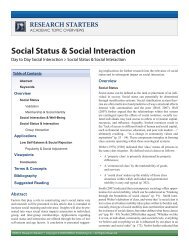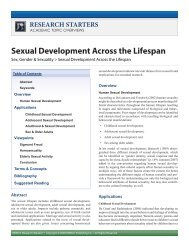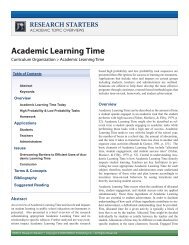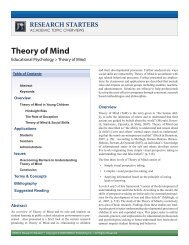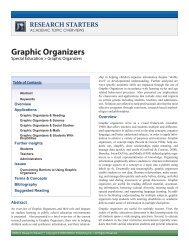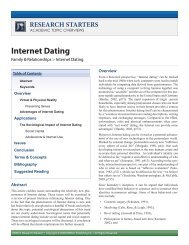Self-Determination Theory - DSWLeads.com
Self-Determination Theory - DSWLeads.com
Self-Determination Theory - DSWLeads.com
You also want an ePaper? Increase the reach of your titles
YUMPU automatically turns print PDFs into web optimized ePapers that Google loves.
RESEARCH STARTERS<br />
ACADEMIC TOPIC OVERVIEWS<br />
<strong>Self</strong>-<strong>Determination</strong> <strong>Theory</strong><br />
Educational Psychology > <strong>Self</strong>-<strong>Determination</strong> <strong>Theory</strong><br />
Table of Contents<br />
Abstract<br />
Abstract<br />
Keywords<br />
Overview<br />
The Building Blocks of <strong>Self</strong>-<strong>Determination</strong><br />
Intrinsic Motivation<br />
Extrinsic Motivation<br />
Applications<br />
Motivation in a Public School Setting<br />
Students<br />
Teachers<br />
Administrators<br />
Promoting <strong>Self</strong>-<strong>Determination</strong> in Children<br />
Conclusion<br />
Terms & Concepts<br />
Bibliography<br />
Suggested Reading<br />
<strong>Self</strong>-determination theory is a theory of motivation which posits<br />
that humans continually and actively seek challenges and new<br />
experiences to and develop and master. Within education, the<br />
theory considers that students are motivated to achieve different<br />
objectives. When a behavior is self-determined, the<br />
individual determines that the locus of control is internal to<br />
the self, whereas when the behavior is controlled, the locus of<br />
control is external to self. The important distinction between<br />
the internal or external determinants is not in whether the<br />
behaviors are motivated or intentional, but in their internal regulatory<br />
processes and how the internal regulatory processes drive<br />
external behaviors (Deci, Vallerand, Pelletier, & Ryan, 1991).<br />
Overview<br />
<strong>Self</strong>-determination theory is a theory of motivation which posits<br />
that humans continually and actively seek challenges and new<br />
experiences to and develop and master. Within education, the<br />
theory considers that students are motivated to achieve different<br />
objectives. Unlike other motivational theories, self-determination<br />
theory offers the “distinction that falls within the class<br />
of behaviors that are intentional or motivated. These motivated<br />
actions are self-determined to the extent that they are endorsed<br />
by one’s sense of self” (Deci, Vallerand, Pelletier, & Ryan, 1991,<br />
p. 326). When a behavior is self-determined, the individual<br />
determines that the locus of control is internal to self, whereas<br />
when the behavior is controlled, the locus of control is external<br />
to self. The important distinction between the internal or external<br />
determinants is not in whether the behaviors are motivated or<br />
intentional, but in their internal regulatory processes and how<br />
the internal regulatory processes drive external behaviors. The<br />
qualities of the <strong>com</strong>ponents of the behaviors are vastly different<br />
and need to be understood in order to promote self-determination<br />
in a classroom environment (Deci, et al., 1991, p. 327).<br />
The Building Blocks of <strong>Self</strong>-<strong>Determination</strong><br />
Intrinsic Motivation<br />
The most self-determined type of behavior is intrinsic motivation.<br />
These behaviors are induced for their own sake, and are linked<br />
to feelings of pleasure, interest and satisfaction derived directly<br />
from participation in the behavior. Individuals that are intrinsically<br />
motivated engage in behaviors because of internal feelings<br />
of satisfaction derived from the behavior. While engaging in these<br />
behaviors, humans are self-regulated, interested in the activity,<br />
choosing to engage in the activity, and function without the aid<br />
of external rewards or constraints (Deci & Ryan, 1985). Thus,<br />
intrinsic behaviors are initiated because the individual chooses<br />
to engage in the activity according to their own wishes. When a<br />
EBSCO Research Starters ® • Copyright © 2008 EBSCO Publishing Inc. • All Rights Reserved
<strong>Self</strong>-<strong>Determination</strong> <strong>Theory</strong><br />
Essay by Sharon Link, Ph.D.<br />
Keywords<br />
Autonomy<br />
Competence<br />
Extrinsic Motivation<br />
Goals<br />
Intrinsic Motivation<br />
Learner-Centered<br />
Locus of Control<br />
<strong>Self</strong>-<strong>Determination</strong> <strong>Theory</strong><br />
child chooses a specific book to read and reads it just for the sake<br />
of enjoyment, this exemplifies intrinsic motivation.<br />
Extrinsic Motivation<br />
Extrinsic behaviors are “instrumental in nature. They are not performed<br />
out of interest, but rather because they are believed to be<br />
instrumental” in producing a desired out<strong>com</strong>e. While research<br />
previously has indicated that extrinsic motivation is not a building<br />
block of self-determination, recent research has suggested<br />
that “these behavioral types differ in the extent to which they represent<br />
self-determined behaviors in contrast to a more controlled<br />
response. The determining factor that makes these behaviors<br />
more self-determined” rather than extrinsic is the factor of internalization<br />
(Deci, Vallerand, Pelletier, & Ryan, 1991, p. 328).<br />
Internalization is a proactive process through which individuals<br />
transform their regulatory processes into internal processes<br />
(Schafer, 1968). In self-determination processes, internalization<br />
is viewed as a motivated process. <strong>Self</strong>-determination theorists<br />
report that they believe that (a) people are innately induced to<br />
internalize and integrate within themselves “the regulation of<br />
uninteresting activities that are useful for effective functioning in<br />
the social world” and (b) that the extent to which the process of<br />
internalization and integration proceeds effectively is a “function<br />
of the social context.” The four types of extrinsic motivation that<br />
can be integrated within the interpersonal framework include:<br />
• External,<br />
• Introjected,<br />
• Identified,<br />
• Integrated regulation (Deci, et al., 1991, p. 328).<br />
External Regulation<br />
External regulation behaviors are “performed because of an<br />
external contingency, and are considered the loci of initiation and<br />
regulation. External regulation represents the least self-determined<br />
form of extrinsic motivation”. External regulation behaviors are<br />
typically induced by the offer of reward or punishment. An individual<br />
displaying external regulation is an individual that might<br />
study just because they know they will be rewarded for doing well<br />
(Deci, Vallerand, Pelletier, & Ryan, 1991, p. 328).<br />
Identified Regulation<br />
Identification is “the process of identifying with the value of an<br />
activity and accepting regulation of the activity as one’s own”<br />
(Vansteenkiste, Lens & Deci, 2006, p. 21). When individuals<br />
value the personal relevance of an activity and willingly engage in<br />
the activity, then this represents a more significant form of internalization<br />
than other types of externalization. While behaviors<br />
resulting from identification are still extrinsic in nature, identified<br />
regulation occurs because of one’s own volition, which approximates<br />
intrinsic motivation. In this way, identification behavior<br />
integrates the two types of motivation into a <strong>com</strong>posite behavior.<br />
An individual executing identification behavior may study a<br />
given subject despite personal difficulty or dislike; for example,<br />
because the student knows the subject is integral in fulfilling a<br />
self-selected goal (Vansteenkiste, Lens & Deci, 2006). While the<br />
student may express personal distaste for a specific area like statistics,<br />
the student realizes and understands the importance of the<br />
course of study in helping them achieve their goal.<br />
Integrated Regulation<br />
In the case of integrated regulation, the behavior is fully integrated<br />
within the individual’s sense of self. These identifications<br />
are <strong>com</strong>bined with the individual’s other sense of their values,<br />
needs, and identities. A student might have one view of self interpretation<br />
as a good student and the other as a good athlete. While<br />
these two self identities may seem conflicting and cause internal<br />
tensions for the student, the two can be<strong>com</strong>e integrated and dwell<br />
harmoniously within the person and with the students’ sense of<br />
self. When this internal harmony is realized then the integrated<br />
processes are <strong>com</strong>pletely self-willed and mainly occur in adult<br />
stages of development. Integrated regulation appears to be very<br />
similar to intrinsic motivation, because both integrated regulation<br />
and intrinsic motivation cause willing behaviors, develop<br />
creativity, and prosper understanding. However, intrinsic motivation<br />
is different than integrated regulation even though they<br />
seem similar in many ways (Deci, et al., 1991, p. 330).<br />
Applications<br />
Motivation in a Public School Setting<br />
In a public school setting, self-determination, or “studentdirected<br />
learning” involves teaching students multiple strategies<br />
that allow them to regulate and direct their own behavior (Agran,<br />
King-Sears, Wehmeyer, & Copeland, 2003). Student directed<br />
educational strategies are aimed at teaching students to set appropriate<br />
goals for themselves, self-monitor their own performances,<br />
identify solutions to present or future problems, verbally direct<br />
their own behaviors, reinforce their own behaviors, and evaluate<br />
their own performances (Agran, Hong, & Blankenship, 2007, p.<br />
453). These are general strategies and out<strong>com</strong>es that can be uti-<br />
EBSCO Research Starters ® • Copyright © 2008 EBSCO Publishing Inc. • All Rights Reserved Page 2
<strong>Self</strong>-<strong>Determination</strong> <strong>Theory</strong><br />
Essay by Sharon Link, Ph.D.<br />
lized to create a student directed learning environment.<br />
Research has suggested that teachers utilize a multitude of<br />
teaching strategies to create student directed “learner centered<br />
environments.” In learner-centered classrooms, teachers<br />
are attentive to issues surrounding children’s “cognitive and<br />
metacognitive development, the affective and motivational<br />
dimensions of instruction, the developmental and social aspects<br />
of learning, and individual differences in learning strategies that<br />
are in part, associated with children’s cultural and social backgrounds”<br />
(Daniels & Perry, 2003, p. 102). In learner centered<br />
classrooms, teachers provide several teaching practices that are<br />
motivational. Strategies that are used are numerous and include:<br />
• Motivating students by providing a range of instructional<br />
activities relevant to children’s lives and differentiated<br />
according to an individual’s developmental needs;<br />
• Frequently interacting with students to monitor development<br />
and progress and providing help as needed; and<br />
• Creating positive relationships with children to address<br />
socio-emotional and developmental needs (p. 102).<br />
Within this framework, the most important element of these<br />
learner centered strategies is the children’s perceptions of teacher<br />
strategies that they determine to be motivational.<br />
In one interview, children of elementary school age indicated<br />
several strategies that promoted motivation in a learning environment.<br />
Children reported the desire to be known as a “unique<br />
person and learner.” Children also desired to be known as an<br />
individual and felt secure afterward. Eventually, as students<br />
matured, they reported feeling less reliant on teachers and more<br />
reliant on peers. Children reported the need to “participate in<br />
interesting learning activities.” Children expressed boredom<br />
with too many repetitive activities. Another factor children indicated<br />
was they “want to make their own choices…sometimes.”<br />
They reported feeling most empowered when they could make<br />
their own educational choices. Children also indicated the need<br />
to “work with classmates” and reported the desire to work collaboratively<br />
with their peers. All of these factors indicated that<br />
children’s perceptions of learner centered educational environments<br />
promoted student motivation, self-perceived <strong>com</strong>petence,<br />
and achievement (Daniels & Perry, 2003, p. 106). The perceptions<br />
of children regarding their own learning hold several<br />
implications for how learning centered strategies can be applied<br />
in educational settings.<br />
Students<br />
Rewards such as prizes and money have long been used to motivate<br />
students to promote success in school. However, research<br />
conducted thirty years ago demonstrated that students who participated<br />
in activities and received rewards tended to lose interest<br />
in and the willingness to work on the activity in the absence of<br />
rewards. Other research seeking to outline primary differences<br />
between internalization and intrinsic rewards, demonstrated that<br />
rewards for work consistently indicates that these behaviors seek<br />
to control behavior at an operational level, but also these behaviors<br />
“undermine intrinsic motivation for interesting tasks and<br />
impeded internalization of regulations for uninteresting tasks”<br />
(Deci, et al., 1991). Other “external events designed to motivate<br />
or control people including deadlines and <strong>com</strong>petition were similarly<br />
determined to decrease intrinsic motivation” (Deci, et al.,<br />
1991, p. 335). All of these behaviors elicit external controls on<br />
behaviors. When an individual’s sense of autonomy is diminished,<br />
intrinsic motivation is decreased.<br />
In response to students’ behaviors, teachers will also be<strong>com</strong>e<br />
more controlling over students that act fidgety and inattentive<br />
during a lesson. Based on this observation, students that appear<br />
to be more motivated and autonomous in school may elicit a<br />
greater amount of respect and support derived from the behavior<br />
of the student and the teacher’s assumptions regarding these indicators<br />
(Deci, et al., 1991, p. 341). In response to this research, it<br />
can be concluded that the most effective internalization and selfdetermined<br />
form of regulation will occur in students if<br />
• Children are able to understand the value and application<br />
of a given activity;<br />
• Are provided choices regarding the activity; and<br />
• If their feelings and perspectives are acknowledged<br />
(Grolnick & Ryan, 1989).<br />
This research further implies that teachers have a deep responsibility<br />
for promoting these classroom structures.<br />
Teachers<br />
Deci, Schwartz, et al. (1981) reasoned that some teachers were<br />
more supportive of student autonomy, while other teachers<br />
were more oriented toward controlling their students and their<br />
behaviors. Results from their study indicated that students in<br />
classrooms of teachers who supported student autonomy were<br />
more likely to demonstrate intrinsic motivation, academic <strong>com</strong>petence,<br />
and self-esteem than students learning in classrooms of<br />
controlling teachers (Deci, et al., 1991, p. 337). Other studies<br />
have demonstrated that students in classrooms with supportive<br />
teachers were more likely to:<br />
• Stay in school (Vallerand, Fortier, & Guay, 1997),<br />
• Experience enhanced creativity (Koestner, Ryan,<br />
Bernieri, & Holt, 1984),<br />
• Develop a preference for optimal challenge (Shapira,<br />
1976), and greater conceptual understanding (Benware<br />
& Deci, 1984, Grolnick & Ryan, 1987),<br />
• Develop more positive emotionality (Patrick, Skinner,<br />
& Connell, 1993),<br />
• Possess higher academic intrinsic motivation (Deci,<br />
Nezlek, & Sheinman, 1981),<br />
• Produce better academic performance (Boggiano,<br />
Flink, Shields, Seelbach, & Barrett, 1993), and<br />
• Higher academic achievement (Flink, Boggiano, Main,<br />
Barrett & Katz, 1992).<br />
EBSCO Research Starters ® • Copyright © 2008 EBSCO Publishing Inc. • All Rights Reserved Page 3
<strong>Self</strong>-<strong>Determination</strong> <strong>Theory</strong><br />
Essay by Sharon Link, Ph.D.<br />
These are strong indicators of the role of the teacher in providing<br />
academic structures that empower and motivate students’ success.<br />
Teachers can very easily fall into academic structures that disempower<br />
students and cause them to rely too heavily on the teacher<br />
for support and learning. From an observed standpoint, students<br />
that rely too heavily on their teachers for support are less apt to<br />
thrive in academic environments when teachers stylistically do<br />
not provide systematic control over all aspects of the learning<br />
environment. In other words, teachers that provide their students<br />
with an autonomous classroom setting are able to nurture more<br />
active learning from their students and promote student potential.<br />
This statement is supported by other research that demonsrated<br />
that a teacher’s supportive style that respected and valued students,<br />
rather than neglected or frustrated them, nurtured high<br />
interest, motivation, and achievement (Goodenow, 1993; Midgley,<br />
Feldlaufer, & Eccles, 1989; Ryan & Grolnick, 1986).<br />
Administrators<br />
Deci, Spiegel, Ryan, Koestner, and Kaufmann (1982) indicated<br />
that when teachers feel pressured or controlled by their superiors<br />
regarding student out<strong>com</strong>es, they were more likely to control<br />
their students. In studies conducted to determine the impact of<br />
teachers under pressure in contrast to less control, evidence indicated<br />
“that when teachers were more controlling of students,<br />
students performed less well in problem-solving activities, both<br />
during instruction” (Deci, et al., 1991, p. 340) and subsequent to<br />
the instruction. Pressure from administrators to ensure student<br />
controls directly related to the autonomy and support provided<br />
by teachers to students (Deci, et al., 1991). Central to these<br />
administrative controls, other controls included mandates made<br />
by “government agencies, parent groups, and other forces outside<br />
of the school system also produced a negative impact on<br />
students’ self determination, conceptual learning, and personal<br />
adjustment” (p. 340). Maehr (1991) determined that classroom<br />
practices are dictated in large part by school policies. Administrators<br />
certainly should be aware of their role in creating a school<br />
environment that nurtures the child’s frame of reference. Specific<br />
supports for self-determination includes offering some choices,<br />
minimizing harsh controls, acknowledging feelings, and making<br />
information available for decision making and for performing<br />
target tasks.<br />
Promoting <strong>Self</strong> <strong>Determination</strong> in Children<br />
Professional development that supports teachers in better understanding<br />
learning through a child’s lens is vital to enabling<br />
educational professionals to structure learning environments<br />
that are child centered. The relationships between administrators,<br />
parents, and teachers are also central to understanding the<br />
needs of the child. It is re<strong>com</strong>mended practice in the learnercentered<br />
educational environment that “talking with children’s<br />
parents can often fill in the gaps concerning children’s learning<br />
interests and experiences outside school” (Daniels & Perry,<br />
2003, p. 106). Furthermore, collecting background information<br />
and knowledge about individual children is “necessary” for providing<br />
meaningful and appropriately challenging activities that<br />
will enable children to be the most successful in their academic<br />
endeavors. These opportunities factor heavily in creating and<br />
honoring a “system of diversity” and enable differentiated learning<br />
for individual student needs while supporting teachers in<br />
diverse educational environments. Utilizing these strategies and<br />
understanding the needs of the child are the first indicators of<br />
educational environments designed to promote self-determination<br />
in children(Daniels & Perry, 2003).<br />
Conclusion<br />
Teachers must understand self-determination theory and use<br />
ways of teaching students that are intrinsically motivating to<br />
prosper academic success for children. Schools have changed<br />
dramatically over the last thirty years in the way discipline is<br />
approached and in how relationships among students, teachers,<br />
administrators, and parents are structured.<br />
For new teachers entering an educational setting, unfamiliar with<br />
the curricula mandates of a given school and the students, offering<br />
students choices about their learning, building relationships with<br />
parents, and supporting students to develop a deep understanding<br />
of themselves as learners are central to gaining insight into<br />
the framework of the learner-centered classroom. To learn new<br />
curricula in a given grade level takes approximately one year to<br />
explore. When teachers realize the choices within given curricula<br />
and allow students the opportunity to co-explore, it simply creates<br />
less work for the new teacher, because this system allows the students<br />
a good share of the responsibility for their own learning.<br />
New teachers are often caught up in creating much of their<br />
own curriculum, <strong>com</strong>prehension questions, and paper-and-pencil<br />
activities that could be alleviated by giving students more<br />
choices. To further ensure classroom successes, new teachers<br />
need to <strong>com</strong>municate their goals with others, including parents.<br />
After all, when students are placed in charge of much of their<br />
own learning the responsibility for success be<strong>com</strong>es shared and<br />
places more accountability on all parties, in turn easing teachers<br />
from carrying the whole burden for students’ success.<br />
Terms & Concepts<br />
Autonomy: Autonomy in a learning environment can be<br />
described as possessing the independent ability to make an<br />
academic choice and act on that choice.<br />
Competence: Competence in a learning environment can be<br />
described as doing an activity well or to a required standard.<br />
Extrinsic Motivation: Extrinsic motivation can be ascribed<br />
to behaviors that are performed out to avoid risk or seek<br />
reward. Behaviors that occur as a result of extrinsic motivation<br />
are not performed because of an individual’s deep interest, but<br />
are performed because they are believed to be instrumental in<br />
producing a desired out<strong>com</strong>e.<br />
Intrinsic Motivation: Intrinsic motivation can be described<br />
EBSCO Research Starters ® • Copyright © 2008 EBSCO Publishing Inc. • All Rights Reserved Page 4
<strong>Self</strong>-<strong>Determination</strong> <strong>Theory</strong><br />
Essay by Sharon Link, Ph.D.<br />
ascribed to behaviors that are performed because of the internal<br />
desire and regulation of the individual performing the behavior.<br />
These are behaviors that elicit joy and pleasure to the individual<br />
without external regulators promoting the behavior.<br />
<strong>Self</strong>-<strong>Determination</strong> <strong>Theory</strong>: A theory of motivation which<br />
posits that humans continually and actively seek challenges and<br />
new experiences to and develop and master. Within education,<br />
the theory considers that students are motivated to achieve different<br />
objectives.<br />
Bibliography<br />
Agran, M., King-Sears, M., Wehmeyer, M., & Copeland, S.<br />
(2003). Teacher’s guide to inclusive practice: Studentdirected<br />
learning. Baltimore, MD: Paul H. Brookes.<br />
Agran, M., Hong, S., & Blankenship, K. (2007). Promoting<br />
the self-determination of students with visual impairments:<br />
Reducing the gap between knowledge and practice.<br />
Journal of Visual Impairment & Blindness, 101(8), 453<br />
– 464. Retrieved November 7, 2007 from EBSCO Online<br />
Database Academic Search Premier. http://search.ebscohost.<strong>com</strong>/login.aspx?direct=true&db=aph&AN=26363407<br />
&site=ehost-live<br />
Amabile, T. M., Dejong, W., & Lepper, M. R. (1976). Effects<br />
of externally imposed deadlines on subsequent intrinsic<br />
motivation. Journal of Personality and Social Psychology,<br />
34, 915 – 922.<br />
Benware, C., & Deci, E. L. (1984). The quality of learning<br />
with an active versus passive motivational set. American<br />
Educational Research Journal, 21, 755 – 765.<br />
Boggiano, A. K., Flink, C., Shields, A., Seelbach, A., &<br />
Barrett, M. (1993). Use of techniques promoting students’<br />
self-determination: Effects on students’ analytic problemsolving<br />
skills. Motivation and Emotion, 17, 319 – 336.<br />
Daniels, D., & Perry, K. (2003), “Learner-centered” according<br />
to children. <strong>Theory</strong> into Practice, 42(2), 102 – 108.<br />
Retrieved November 7, 2007 from EBSCO Online<br />
Database Academic Search Premier. http://search.ebscohost.<strong>com</strong>/login.aspx?direct=true&db=aph&AN=9923516<br />
&site=ehost-live<br />
Deci, E. L., Betley, G., Kahle, J., Abrams, L., & Porac, J.<br />
(1981). When trying to win: Competition and intrinsic<br />
motivation. Personality and Social Psychology Bulletin, 7,<br />
79 – 83.<br />
Deci, E. L., Nezlek, J., & Sheinman, L. (1981). Characteristics<br />
of the rewarder and intrinsic motivation of the rewardee.<br />
Journal of Personality and Social Psychology, 40, 1 – 10.<br />
Deci, E. L. & Ryan, R. M. (1985). The General Causality<br />
Orientations Scale: <strong>Self</strong>-determination in personality.<br />
Journal or Research in Personality, 19, 109 – 134.<br />
Deci, E. L. & Ryan, R. M. (1991). A motivation approach<br />
to self: Integration in personality. In R. Dienstbier<br />
(Ed.), Nebraska Symposium on Motivation: Vol. 38.<br />
Perspectives on motivation (pp. 237 – 288). Lincoln:<br />
University of Nebraska Press.<br />
Deci, E. L., & Ryan, R. M. (2000). <strong>Self</strong>-determination theory<br />
and the facilitation of intrinsic motivation, social development,<br />
and well being. American Psychologist, 55, 68 – 78.<br />
Deci, E. L., & Ryan, R. M. (2002). Overview of self-determination<br />
theory: An organismic dialectical perspective. In<br />
E. L. Deci & R. M. Ryan (Eds.), Handbook on self-determination<br />
research (pp. 3 – 33), Rochester, NY: University<br />
of Rochester Press.<br />
Deci, E. L., Schwartz, A., Sheinman, L., & Ryan, R. M.<br />
(1981). An instrument to assess adults’ orientations toward<br />
control versus autonomy with children: Reflections on<br />
intrinsic motivation and perceived <strong>com</strong>petence. Journal of<br />
Educational Psychology, 73, 642 – 650.<br />
Deci, E. L., Spiegel, N. H., Ryan, R. M., Koestner, R., &<br />
Kauffman, M. (1982). Effects of performance standards<br />
on teaching styles: Behavior of controlling teachers.<br />
Journal of Educational Psychology, 74, 852 – 859.<br />
Deci, E. L., Vallerand, R. J., Pellitier, L. G., & Ryan, R. M.<br />
(1991). Motivation and education: The self-determination<br />
perspective. Educational Psychology, 26(3), 325 – 346.<br />
Retrieved November 7, 2007 from EBSCO Online<br />
Database Academic Search Premier. http://search.ebscohost.<strong>com</strong>/login.aspx?direct=true&db=aph&AN=6370941<br />
&site=ehost-live<br />
Flink, C., Boggiano, A. K., Main, D. S., Barrett, M., & Katz,<br />
P. A. (1992). Children’s achievement-related behaviors:<br />
The role of extrinsic and intrinsic motivational orientations.<br />
In A. K. Boggiano & T. S. Pittman (Eds.),<br />
Achievement and motivation: A socio-developmental perspective<br />
(pp. 189 – 214). New York: Cambridge University<br />
Press.<br />
Goodenow, C. (1993). Classroom belonging among early adolescent<br />
students: Relationships to motivation and achievement.<br />
Journal of Early Adolescence, 13, 21 – 43.<br />
Grolnick, W. S., & Ryan, R. M. (1987). Autonomy in children’s<br />
learning: An experimental and individual difference<br />
investigation. Journal of Personality and Social<br />
Psychology, 52, 890 – 898.<br />
Grolnick, W. S., & Ryan, R. M. (1989). Parent styles associ-<br />
EBSCO Research Starters ® • Copyright © 2008 EBSCO Publishing Inc. • All Rights Reserved Page 5
<strong>Self</strong>-<strong>Determination</strong> <strong>Theory</strong><br />
Essay by Sharon Link, Ph.D.<br />
ated with children’s self-regulation and <strong>com</strong>petence in<br />
school. Journal of Educational Psychology, 81, 143 - 154.<br />
Koestner, R., Ryan, R. M., Bernieri, F., & Holt, K. (1984).<br />
Setting limits on children’s behavior: The differential<br />
effects of controlling versus informational styles on<br />
intrinsic motivation and creativity. Journal of Personality,<br />
52, 233 – 248.<br />
Maehr, M. L. (1991). Changing the schools: A word to school<br />
leaders about enhancing student investment in learning.<br />
Paper presented at the annual conference of the American<br />
Educational Research Association, Chicago.<br />
Midgley, C., Feldlaufer, H., & Eccles, J. S. (1989). Student/<br />
teacher relations and attitudes toward mathematics before<br />
and after the transition to junior high school. Child<br />
Development, 60, 981 – 992. Retrieved November 7, 2007<br />
from EBSCO Online Database Academic Search Premier.<br />
http://search.ebscohost.<strong>com</strong>/login.aspx?direct=true&db=a<br />
ph&AN=9676559&site=ehost-live<br />
Mossholder, K. W. (1980). Effects of externally mediated goal<br />
setting on intrinsic motivation: A laboratory experiment.<br />
Journal of Applied Psychology, 65, 202 – 210.<br />
Patrick, B. C., Skinner, E. A., & Connell, J. P. (1993). What<br />
motivates children’s behavior and emotion? Joint effects<br />
of perceived control and autonomy in the academic<br />
domain. Journal of Personality and Social Psychology,<br />
65, 781 – 791.<br />
Ryan, R. M., & Grolnick, W. S. (1986). Origins and pawns in<br />
the classroom: <strong>Self</strong>-report and projective assessments of<br />
individual differences in children’s perceptions. Journal<br />
of Personality and Social Psychology, 50, 550 – 558.<br />
Schafer, R. (1968). Aspects of internalization. New York:<br />
International Universities Press.<br />
Vallerand, R. J., Fortier, M. S. & Guay, F. (1997). <strong>Self</strong>determination<br />
and persistence in a real-life setting:<br />
Toward a motivational model of high-school drop out.<br />
Journal of Personality and Social Psychology, 72, 1161 –<br />
1176.<br />
Vallerand, R. J., Gauvin, L. L., & Halliwell, W. R. (1986).<br />
Negative effects of <strong>com</strong>petition on children’s intrinsic<br />
motivation. Journal of Social Psychology, 126, 649 – 657.<br />
Vallerand, R. J., Hamel, M., & Daoust, H. (1991). Cooperation<br />
and <strong>com</strong>petition: A test of their relative effects on intrinsic<br />
motivation. Unpublished manuscript, University of<br />
Quebec at Montreal, Montreal Canada.<br />
Vansteenkiste, M., Lens, W., & Deci, E. (2006). Intrinsic<br />
versus extrinsic goal contents in self-determination<br />
theory: Another look at the quality of academic motivation.<br />
Educational Psychology, 4(1), 19 – 31. Retrieved<br />
November 7, 2007 from EBSCO Online Database<br />
Academic Search Premier. http://search.ebscohost.<strong>com</strong>/<br />
login.aspx?direct=true&db=aph&AN=19625395&site=eh<br />
ost-live<br />
Suggested Reading<br />
Atkinson, J. W., & Feather, N. T. (1966). A theory of achievement<br />
motivation. New York: Wiley.<br />
Deci, E. L., & Ryan, R. M. (1985). Intrinsic motivation<br />
and self-determination in human behavior. New York:<br />
Plenum.<br />
Fromm, E. (1976). To have to be? New York: Continuum.<br />
Kasser, T. (2002). The high price of materialism. London: MIT<br />
Press.<br />
Vroom, V. H. (1964). Work and motivation. New York: Wiley.<br />
EBSCO Research Starters ® • Copyright © 2008 EBSCO Publishing Inc. • All Rights Reserved Page 6
<strong>Self</strong>-<strong>Determination</strong> <strong>Theory</strong><br />
Essay by Sharon Link, Ph.D.<br />
Essay by Sharon Link, Ph.D.<br />
Dr. Sharon Link is an educator, presenter, and mother of a child with autism. She has worked extensively in public education and<br />
has researched education and its relationship to autism disorders and other disabilities for the last ten years. Dr. Link currently is the<br />
Executive Director for Autism Disorders Leadership Center, a non-profit research center and is co-founder of Asperger Interventions &<br />
Support, Inc. a professional development center. Both organizations are education and research centers seeking to improve education by<br />
creating a system of diversity and inclusion in America’s schools. To learn more, visit: Asperger Help at http://aspergerhelp.net.<br />
EBSCO Research Starters ® • Copyright © 2008 EBSCO Publishing Inc. • All Rights Reserved Page 7




